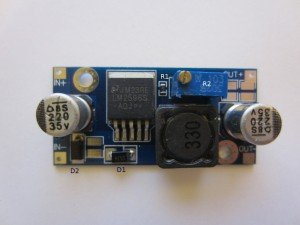LM2596 based step-down DC-DC converter modules can be bought on eBay quite cheaply for around a dollar each. But how do they perform? Is it safe to use it to power your design? Let’s find out.
According to TI’s website, these LM2596 step-down (buck) regulators are sold for $1.8 each for a quantity of a thousand. So how a finished converter could be sold for just above a dollar each is quite a mystery to me. Anyway, the picture below is the board I received. It appears that there are a few variations to this design (slightly different inductor size or capacitor size/voltage rating, etc.) but they all are largely based on the reference design.
Below is the reverse engineered circuit diagram of this particular converter board I have (key components are also marked in the picture above for reference). The inclusion of a polarity protection diode (D2) is certainly a nice feature. It will prevent you from damaging the regulator should the input voltage be reversed. Of course, if the input power supply has very low output impedance and high current capability this tiny diode might not be able to save the board in an input voltage reversal situation. Also, not all variants of this step-down DC-DC converter have this diode. Although LM2596 can handle input voltages up to 45V, the input and output capacitors used are both rated for 35V only so in practice input voltage should stay below 30V for long term uses.
For LM2596, the output voltage is determined by the equation below. Given the component values used in this module the output voltage can be adjusted between 1.23V to 25V.
 23
23 R1R2+1
R1R2+1
Although LM2596 is rated for a maximum current of 3A in continuous operation, the tiny surface area of the ground plane on this board is not sufficient to dissipate the amount of heat generated over the entire operation range of the converter. And the efficiency of this converter varies quite a bit depending on the input voltage, output voltage and the load current. The efficiency can range from 60% to 90% depending on the operating conditions. As you can see in the video later, a heatsink is a must if continuous operation at over 1A is required.
According to the datasheet, a feedforward capacitor is needed in parallel of R2 when the output voltage is greater than 10V to ensure stability. But this capacitor is not present on this converter board. Even though in my limited testing the module was able to work across its output range, I would not recommend using this module to supply power to sensitive devices if higher than 10V supply voltage is needed. Instabilities could cause the output to deviate from the set voltage.
Simple switching regulators are typically designed to work optimally within a small range of output voltages once the key components (e.g. the inductor) had been chosen. This can be clearly seen from the datasheet in choosing inductors and output capacitors.
In the video below, I tested this DC-DC converter board under various operating conditions and measured its efficiencies. To conclude, these switching regulator boards are well suited for low to medium current draw digital circuitry but for higher current applications a heat sink is needed and even so I would not recommend running it at the maximum 3A load especially if the input voltage is high.
For more detail: LM2596 DC-DC Converter Module Testing


